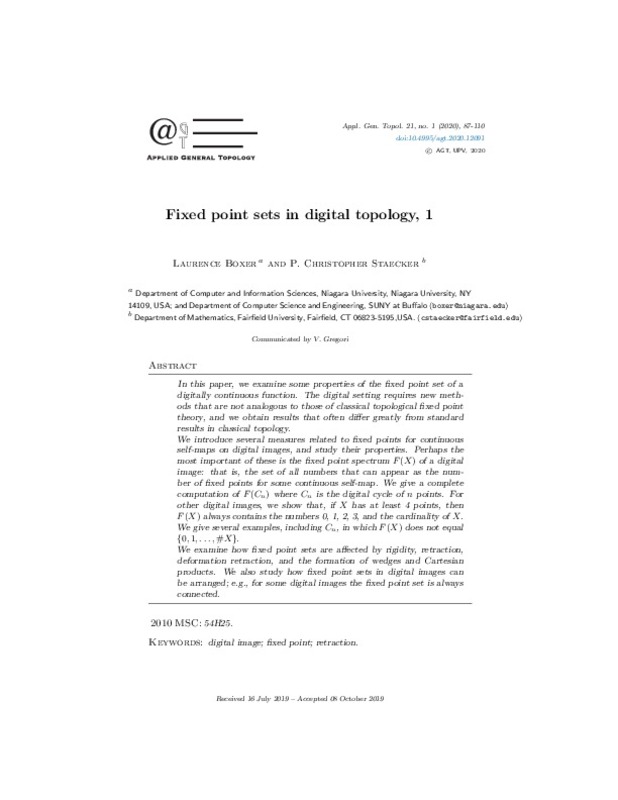JavaScript is disabled for your browser. Some features of this site may not work without it.
Buscar en RiuNet
Listar
Mi cuenta
Estadísticas
Ayuda RiuNet
Admin. UPV
Fixed poin sets in digital topology, 1
Mostrar el registro sencillo del ítem
Ficheros en el ítem
| dc.contributor.author | Boxer, Laurence
|
es_ES |
| dc.contributor.author | Staecker, P. Christopher
|
es_ES |
| dc.date.accessioned | 2020-04-27T09:09:27Z | |
| dc.date.available | 2020-04-27T09:09:27Z | |
| dc.date.issued | 2020-04-03 | |
| dc.identifier.issn | 1576-9402 | |
| dc.identifier.uri | http://hdl.handle.net/10251/141555 | |
| dc.description.abstract | [EN] In this paper, we examine some properties of the fixed point set of a digitally continuous function. The digital setting requires new methods that are not analogous to those of classical topological fixed point theory, and we obtain results that often differ greatly from standard results in classical topology. We introduce several measures related to fixed points for continuous self-maps on digital images, and study their properties. Perhaps the most important of these is the fixed point spectrum F(X) of a digital image: that is, the set of all numbers that can appear as the number of fixed points for some continuous self-map. We give a complete computation of F(Cn) where Cn is the digital cycle of n points. For other digital images, we show that, if X has at least 4 points, then F(X) always contains the numbers 0, 1, 2, 3, and the cardinality of X. We give several examples, including Cn, in which F(X) does not equal {0, 1, . . . , #X}. We examine how fixed point sets are affected by rigidity, retraction, deformation retraction, and the formation of wedges and Cartesian products. We also study how fixed point sets in digital images can be arranged; e.g., for some digital images the fixed point set is always connected. | es_ES |
| dc.language | Inglés | es_ES |
| dc.publisher | Universitat Politècnica de València | es_ES |
| dc.relation.ispartof | Applied General Topology | es_ES |
| dc.rights | Reconocimiento - No comercial - Sin obra derivada (by-nc-nd) | es_ES |
| dc.subject | Digital image | es_ES |
| dc.subject | Fixed point | es_ES |
| dc.subject | Retraction | es_ES |
| dc.title | Fixed poin sets in digital topology, 1 | es_ES |
| dc.type | Artículo | es_ES |
| dc.identifier.doi | 10.4995/agt.2020.12091 | |
| dc.rights.accessRights | Abierto | es_ES |
| dc.description.bibliographicCitation | Boxer, L.; Staecker, PC. (2020). Fixed poin sets in digital topology, 1. Applied General Topology. 21(1):87-110. https://doi.org/10.4995/agt.2020.12091 | es_ES |
| dc.description.accrualMethod | OJS | es_ES |
| dc.relation.publisherversion | https://doi.org/10.4995/agt.2020.12091 | es_ES |
| dc.description.upvformatpinicio | 87 | es_ES |
| dc.description.upvformatpfin | 110 | es_ES |
| dc.type.version | info:eu-repo/semantics/publishedVersion | es_ES |
| dc.description.volume | 21 | es_ES |
| dc.description.issue | 1 | es_ES |
| dc.identifier.eissn | 1989-4147 | |
| dc.relation.pasarela | OJS\12091 | es_ES |
| dc.description.references | C. Berge, Graphs and Hypergraphs, 2nd edition, North-Holland, Amsterdam, 1976. | es_ES |
| dc.description.references | L. Boxer, Digitally continuous functions, Pattern Recognition Letters 15 (1994), 833-839. https://doi.org/10.1016/0167-8655(94)90012-4 | es_ES |
| dc.description.references | L. Boxer, A classical construction for the digital fundamental group, Journal of Mathematical Imaging and Vision 10 (1999), 51-62. https://doi.org/10.1023/A:1008370600456 | es_ES |
| dc.description.references | L. Boxer, Continuous maps on digital simple closed curves, Applied Mathematics 1 (2010), 377-386. https://doi.org/10.4236/am.2010.15050 | es_ES |
| dc.description.references | L. Boxer, Generalized normal product adjacency in digital topology, Applied General Topology 18, no. 2 (2017), 401-427. https://doi.org/10.4995/agt.2017.7798 | es_ES |
| dc.description.references | L. Boxer, Alternate product adjacencies in digital topology, Applied General Topology 19, no. 1 (2018), 21-53. https://doi.org/10.4995/agt.2018.7146 | es_ES |
| dc.description.references | L. Boxer, Fixed points and freezing sets in digital topology, Proceedings, 2019 Interdisciplinary Colloquium in Topology and its Applications, in Vigo, Spain; 55-61. | es_ES |
| dc.description.references | L. Boxer, O. Ege, I. Karaca, J. Lopez, and J. Louwsma, Digital fixed points, approximate fixed points, and universal functions, Applied General Topology 17, no. 2 (2016), 159-172. https://doi.org/10.4995/agt.2016.4704 | es_ES |
| dc.description.references | L. Boxer and I. Karaca, Fundamental groups for digital products, Advances and Applications in Mathematical Sciences 11, no. 4 (2012), 161-180. | es_ES |
| dc.description.references | L. Boxer and P. C. Staecker, Remarks on fixed point assertions in digital topology, Applied General Topology 20, no. 1 (2019), 135-153. https://doi.org/10.4995/agt.2019.10474 | es_ES |
| dc.description.references | J. Haarmann, M. P. Murphy, C. S. Peters and P. C. Staecker, Homotopy equivalence in finite digital images, Journal of Mathematical Imaging and Vision 53 (2015), 288-302. https://doi.org/10.1007/s10851-015-0578-8 | es_ES |
| dc.description.references | B. Jiang, Lectures on Nielsen fixed point theory, Contemporary Mathematics 18 (1983). https://doi.org/10.1090/conm/014 | es_ES |
| dc.description.references | E. Khalimsky, Motion, deformation, and homotopy in finite spaces, in Proceedings IEEE Intl. Conf. on Systems, Man, and Cybernetics (1987), 227-234. | es_ES |
| dc.description.references | A. Rosenfeld, "Continuous" functions on digital pictures, Pattern Recognition Letters 4 (1986), 177-184. https://doi.org/10.1016/0167-8655(86)90017-6 | es_ES |
| dc.description.references | P. C. Staecker, Some enumerations of binary digital images, arXiv:1502.06236, 2015. | es_ES |








